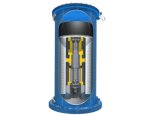Beacon Power Corp. in the USA recently completed connection of a second megawatt of flywheel energy storage to the New England power grid. The new system provides frequency regulation services.
Operators of power grids need to maintain electric frequency very close to 60 hertz (Hz), or cycles per second (50 Hz in Europe and elsewhere). When the supply of electricity exactly matches the load, the grid is considered stable. Maintaining this stability comes at a cost of around one percent of total generation capacity to increase or decrease power output in response to frequency deviations and in doing so, creates greater wear and tear on equipment and greater quantities of carbon dioxide and other emissions. Beacon’s advanced flywheel-based energy storage technology perform fast-response frequency regulation to help mitigate some of these issues.
Flywheels are an alternative to deep cycle batteries or molten salt for storing energy that can be transformed into electricity. Flywheel energy storage works by accelerating a rotor (flywheel) to incredibly high speeds and maintaining the energy in the system as rotational energy, which is converted back by slowing down the flywheel.
Beacon’s Smart Energy 25 flywheel is sealed in a vacuum chamber and spins between 8,000 and 16,000 rpm. At 16,000 rpm the flywheel can store and deliver 25 kWh of extractable energy. At 16,000 rpm, the surface speed of the rim would be approximately Mach 2 – or about 2,400 kmh. The vacuum chamber reduces friction and energy losses and the rotor is also levitated with a combination of permanent magnets and an electromagnetic bearing.
Flywheel energy storage may form an important part of ensuring baseload energy supply from solar power and wind energy in the future. Kinetic energy can be stored in banks of flywheels while conditions are optimal, to be tapped and converted to electricity during the night, on heavily overcast days or in calm conditions.












































